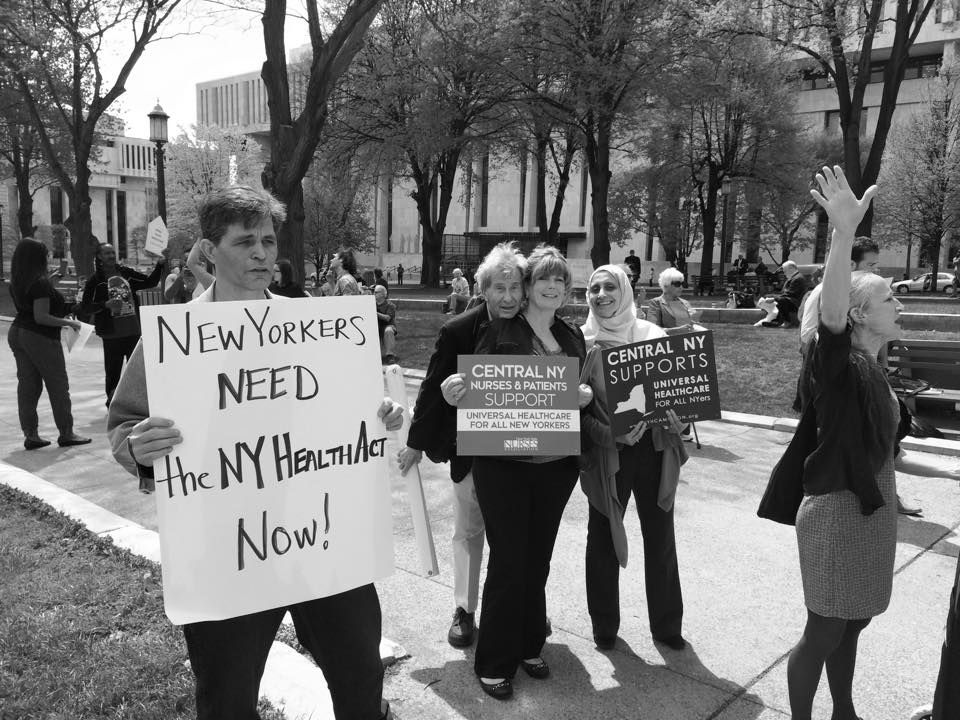On May 27, the New York State Assembly passed the New York Health Act by a vote of 89 to 47. The New York Health Act would provide every New Yorker with all medically necessary healthcare, including rehabilitative care; mental health care, prescription drugs, and medical supplies; and preventive and public health measures. No more rising premiums, no deductibles, no co-pays, everything covered.
A single-payer system in New York could save taxpayers more than $45 billion a year, and 98% of us would pay less for healthcare costs because of the savings from eliminating insurance company profits and lowering administrative costs, according to an analysis by University of Massachusetts at Amherst economist Gerald Friedman. The New York Health Act would be funded through a progressive payroll tax paid 80 percent by employers and 20 percent by employees. New York State would seek waivers so that federal funds now received for New Yorkers in Medicare, Medicaid and Child Health Plus would apply to New York Health.

Assembly member Richard Gottfried first introduced the New York Health Act in 1992. The May 2015 Assembly vote was won thanks to decades of advocacy and organizing by healthcare workers. Today, championing the New York Health Act is a statewide coalition, the Campaign for New York. At the helm are healthcare workers, Physicians for a National Health Plan and New York’s largest nurses unions, the New York Nurses Association and SEIU 1999. Adding their voice to the struggle for health care rights are over 100 labor, faith and community groups. The next big step in winning universal health care in New York will be building up the political energy to pass New York Health in the NYS Senate.
Healthcare vs. Red Scare
Fifty years ago, on July 30, 1965, President Johnson signed Medicare into law as part of his Great Society legislation. The adoption of Medicare came after 20 years of Congressional debate about universal health insurance. In 1945, President Truman called for the creation of a national health insurance fund in a message to Congress. The debate that followed was dominated by the red-baiting of public healthcare as “socialism” by Congressional Republicans and the American Medical Association (AMA). In the most expensive lobbying campaign in US history at the time, the AMA spent $1.5 million to defeat universal healthcare. One pamphlet read, “Would socialized medicine lead to socialization of other phases of life? Lenin thought so.” The AMA and its supporters were very successful in linking national health insurance with rising anti-Communist sentiment. Truman’s plan died in a congressional committee.
Advocates reluctantly scaled down their goals. Discouraged, they worked through the 1950s and 1960s toward a more modest proposal they hoped the country would adopt: hospital insurance for the aged. Enacted for seniors in 1965 and extended to persons with severe disabilities in 1972, Medicare today is very popular, and financially, it’s more efficient than private insurance, with administrative overhead at about 2-3%.
Storytelling and Organizing
On several occasions in recent US history, healthcare advocates have seen political energy rise for passage of universal healthcare. Each little bit of progress has been hard fought. The Affordable Care Act has made insurance easier to obtain but, according to local health care worker Lanika Mabrey, “the system is still very complicated and the costs of healthcare still prevent people from accessing the care they need.” Mabrey was one of 200 New Yorkers to testify at the 2014 NYS Assembly Health Committee hearings on the New York Health Act. She shared her story of avoiding treatment despite having insurance due to costs and as a result, developing a kidney disease. Other testimony included stories of New Yorkers with insurance who are bankrupted by their deductibles; doctors who spend hours on the phone negotiating with insurance companies; and medical students who “signed up for medical school, not business school.”
Universal healthcare organizing is on a historical upswing. Activists in multiple states are pushing forward “healthcare as a human right” campaigns, including Maryland, Vermont, Maine, California and New York. Healthcare workers are leading the legislative charge, but they need all of us to participate in organizing that puts forward the human costs of the health care crisis front and center in the discussion, much like was achieved during the Assembly’s Health Care hearings. You can join the fight for health care for all New Yorkers by visiting the Campaign for New York Health website (www.nyhcampaign.org) to share your story and to get involved with making passage of the New York Health Act inevitable.





